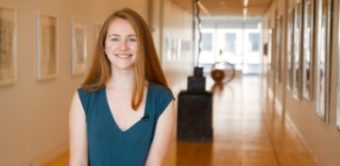Khoury News
Co-ops lead to a job in the fashion industry
By Julia Renner The only way a product can reach a consumer “is if there’s an entire life cycle of technology behind it,” says Theresa Aristarco, who graduated from Northeastern […]

By Julia Renner
The only way a product can reach a consumer “is if there’s an entire life cycle of technology behind it,” says Theresa Aristarco, who graduated from Northeastern University in 2015 with a combined degree in computer science and mathematics. Since then she’s worked as a software engineer in San Francisco at a company few would associate with computer science: The Gap.
Theresa had always been interested in math and science, and her mother, a computer programmer, suggested that she would enjoy the critical thinking and problem-solving involved in computer science. A high school computer science class affirmed her interest in the topic, and she enrolled at Northeastern as a computer science and math combined major. She considered two schools, both with co-op programs, and chose Northeastern because of the program’s strength and location in Boston.
During the first half of her college career, Theresa immersed herself in campus life, becoming a member of NU Women in Tech (formerly Women in Computer Science) and working as a tutor for CCIS. She also followed her interest in dance as a member of No Limits Dance Crew and NU Dance Company. Theresa had always planned to study abroad, and with the intense and focused nature of her combined major, she found the shorter Dialogue of Civilizations trips to be perfect for her schedule. She enrolled in a Dialogue program in Rome, taking City as Text and Italian immersion and sightseeing courses.
Her first co-op then took her across the country, to Intuit in San Diego—the company responsible for programs like TurboTax and QuickBooks. Getting immersed in the tech scene in California, she says, had the biggest impact on her career of any of her college experiences. Her second co-op was at Goldman-Sachs in Boston, and her third took her back to California, living in Cupertino and working for Apple. This final co-op, Theresa says, is what made her certain she wanted to move to the Bay Area.
The strength of the Northeastern alumni community in the tech-oriented Bay Area was another factor in her decision. “There was a strong network of NU alums I became close friends with while working at Apple,” she says, adding that she enjoyed the city and became close with the other Apple co-ops. “I really fell in love with the Bay Area.” With connections in the computer science community and three co-ops under her belt, she was able to start searching for a full-time job for after graduation while she was still on co-op.
Asked whether co-op had an impact on her goals and her career trajectory, Theresa responds, “absolutely. There’s no way I would be at the Gap, living in San Francisco, without the co-op program. It gave me the opportunity to move across the country and have a really amazing job opportunity as an undergrad.” She cites gaining familiarity with the process of interviewing and job negotiations as another benefit of the co-op program. Maybe she could have gotten to the buzzing California computer science scene without co-op, Theresa says, but the co-op experience and having come to the Bay Area so early in her career was what set her up to immediately start working there full-time after graduation.
Looking for entry-level software jobs in San Francisco, she found one at Gap Inc., where she started working immediately after graduating in 2015. “I was most interested in a job when I was interested in the company itself,” Theresa says. “I was familiar with the brand, a fan of the brand, so it clicked for me that it could be a good fit.”
Not many people associate computer science with the clothing industry, and Theresa, too, was surprised to discover the role technology plays for the brand. “You might think of Gap as a clothing company,” she says, “but they have an entire tech company in-house.” She now works as a software engineer with a team that builds the apps used in stores across the country. Sales associates use an iPod Touch with a scanner and card swipe, and the devices are able to look up an order, search for an item in a certain size, or check whether a product is available in the back of the store, online, or at a nearby retail location. From transporting an item to the store to the final customer transaction, “the only way you can get the piece of clothing is if there’s an entire life cycle of technology behind it. For Gap you think of a physical piece of clothing,” Theresa says, “but there’s so much more that goes into getting that to a customer, and it all flows through a technology stack.”